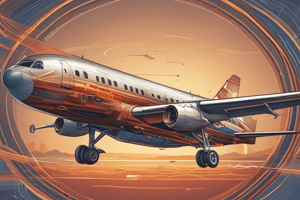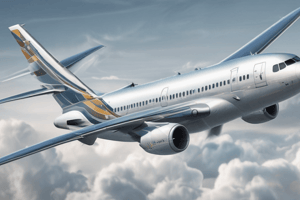Podcast
Questions and Answers
Flaps are hinged surfaces mounted on the ______ edges of the wings of a fixed-wing aircraft.
Flaps are hinged surfaces mounted on the ______ edges of the wings of a fixed-wing aircraft.
trailing
Slats are aerodynamic surfaces on the ______ edge of the wings of fixed-wing aircraft.
Slats are aerodynamic surfaces on the ______ edge of the wings of fixed-wing aircraft.
leading
The general airplane lift equation is: L = ______ * V * S * CL.
The general airplane lift equation is: L = ______ * V * S * CL.
rho
Increasing the area (S) and lift coefficient (CL) allows for the production of a certain ______ of lift at a lower airspeed (V).
Increasing the area (S) and lift coefficient (CL) allows for the production of a certain ______ of lift at a lower airspeed (V).
Flaps shorten ______ and landing distances.
Flaps shorten ______ and landing distances.
Slats are used while ______ or performing manoeuvers which take the aircraft close to the stall.
Slats are used while ______ or performing manoeuvers which take the aircraft close to the stall.
Slats are like flaps only but extended over the ______ edge of the wings.
Slats are like flaps only but extended over the ______ edge of the wings.
The Slat lies flush with the wing ______ edge until reduced aerodynamic forces allow it to extend by way of aerodynamics when needed.
The Slat lies flush with the wing ______ edge until reduced aerodynamic forces allow it to extend by way of aerodynamics when needed.
A ______ is a reduction in the lift coefficient generated by foil as angle of attack increases.
A ______ is a reduction in the lift coefficient generated by foil as angle of attack increases.
The critical angle of attack is typically about ______ degrees.
The critical angle of attack is typically about ______ degrees.
A ______ does not mean that the engine(s) have stopped working, or that the aircraft has stopped moving.
A ______ does not mean that the engine(s) have stopped working, or that the aircraft has stopped moving.
The critical angle of attack is dependent upon the profile of the ______, its platform, its aspect ratio, and other factors.
The critical angle of attack is dependent upon the profile of the ______, its platform, its aspect ratio, and other factors.
Flow separation begins to occur at small angles of attack with attached airflow over the ______ still dominant.
Flow separation begins to occur at small angles of attack with attached airflow over the ______ still dominant.
At the critical angle of attack, separated flow is so dominant that further increases in angle of attack produce less ______ and vastly more drag.
At the critical angle of attack, separated flow is so dominant that further increases in angle of attack produce less ______ and vastly more drag.
The angle at which this occurs is called the critical angle of ______.
The angle at which this occurs is called the critical angle of ______.
Stalls in fixed-wing flight are often experienced as a sudden reduction in ______ as the pilot increases angle of attack.
Stalls in fixed-wing flight are often experienced as a sudden reduction in ______ as the pilot increases angle of attack.
A fixed-wing aircraft during a stall may experience ______ or a change in attitude.
A fixed-wing aircraft during a stall may experience ______ or a change in attitude.
Most aircraft are designed to have a gradual ______ characteristics that will warn the pilot and give the pilot time to react.
Most aircraft are designed to have a gradual ______ characteristics that will warn the pilot and give the pilot time to react.
The critical angle of attack in steady straight and level flight can be attained only at low ______.
The critical angle of attack in steady straight and level flight can be attained only at low ______.
Stalls depend only on ______ of attack, not airspeed, however, because a correlation with airspeed exists.
Stalls depend only on ______ of attack, not airspeed, however, because a correlation with airspeed exists.
The stall speed will vary depending on the airplane's ______, altitude, and configuration (flap setting, etc.).
The stall speed will vary depending on the airplane's ______, altitude, and configuration (flap setting, etc.).
Thrust is the force which moves an aircraft through the ______.
Thrust is the force which moves an aircraft through the ______.
Thrust is a reaction force described quantitatively by ______'s second and third laws.
Thrust is a reaction force described quantitatively by ______'s second and third laws.
Thrust is used to overcome the ______ of an airplane.
Thrust is used to overcome the ______ of an airplane.
When a system expels or accelerates ______ in one direction, the accelerated mass will cause a force of equal magnitude in opposite direction.
When a system expels or accelerates ______ in one direction, the accelerated mass will cause a force of equal magnitude in opposite direction.
The magnitude of the thrust depends on the amount of gas accelerated and on the difference in velocity of the gas through the ______.
The magnitude of the thrust depends on the amount of gas accelerated and on the difference in velocity of the gas through the ______.
A propeller converts shaft power from the engine into ______.
A propeller converts shaft power from the engine into ______.
The propeller blade is an ______ and the definitions for chord, camber, thickness/chord ratio and aspect ratio are the same as those given previously for the wing.
The propeller blade is an ______ and the definitions for chord, camber, thickness/chord ratio and aspect ratio are the same as those given previously for the wing.
The propeller accelerates a large mass of ______ rearwards thereby propelling the Aircraft forward.
The propeller accelerates a large mass of ______ rearwards thereby propelling the Aircraft forward.
Acceleration of ______ produces thrust propelling aircraft forward.
Acceleration of ______ produces thrust propelling aircraft forward.
Flashcards are hidden until you start studying
Study Notes
FLAP & SLATS
- Flaps are hinged surfaces mounted on the trailing edges of an aircraft's wings to reduce the speed at which an aircraft can be safely flown and increase the angle of descent for landing.
- Flaps shorten takeoff and landing distances by lowering the stall speed and increasing drag.
- Slats are aerodynamic surfaces on the leading edge of an aircraft's wings, allowing the wing to operate at a higher angle of attack, producing a higher coefficient of lift, and enabling the aircraft to fly at slower speeds or take off and land in shorter distances.
LIFT EQUATION
- The general airplane lift equation is: L = (1/2) × ρ × V^2 × S × CL
- Increasing the area (S) and lift coefficient (CL) can generate lift at a lower airspeed (V).
SLATS
- Types of Slats:
- Automatic: lies flush with the wing leading edge until reduced aerodynamic forces allow it to extend.
- Fixed: permanently extended, used on specialist low-speed aircraft or when simplicity takes precedence over speed.
- Powered: extension can be controlled by the pilot, commonly used on airliners.
STALL
- A stall is a reduction in lift coefficient generated by a foil as the angle of attack increases beyond a critical point.
- The critical angle of attack is typically around 15 degrees, but can vary depending on the fluid, foil, and Reynolds number.
- Stalling occurs when the wing's ability to create lift is hindered by separated flow, resulting in decreased lift and increased drag.
THRUST
- Thrust is a reaction force described by Newton's second and third laws, generated by expelling or accelerating mass in one direction.
- Thrust is used to overcome the drag of an aircraft, generated by the engines through a propulsion system.
- The propulsion system must be in physical contact with a working fluid to produce thrust, which is often generated through the reaction of accelerating a mass of gas.
PROPELLER
- The propeller blade is an aerofoil, with definitions for chord, camber, thickness/chord ratio, and aspect ratio similar to those for the wing.
- The propeller accelerates a large mass of air rearwards, propelling the aircraft forward.
Studying That Suits You
Use AI to generate personalized quizzes and flashcards to suit your learning preferences.




